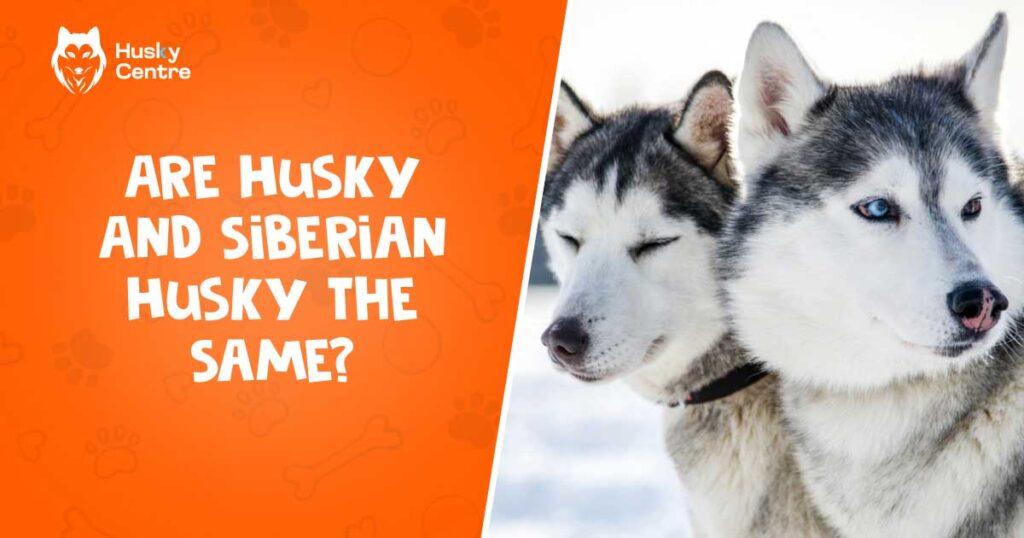No, Husky and Siberian Husky are not exactly the same. Siberian Husky is a type of Husky.
All Siberian Huskies are Huskies, but not all Huskies are Siberian Huskies. People often confuse these two terms. The term “Husky” is broad. It includes various breeds known for pulling sleds. Siberian Huskies are just one of these breeds. They are a popular and recognized type.
But there are other types of Huskies too. Understanding the differences can help you know more about these amazing dogs. In this blog post, we will explore the key differences and similarities between Huskies and Siberian Huskies. This will help you understand each breed better.
Key Differences In Terminology
Are Husky and Siberian Husky the same? This question often comes up among dog lovers and potential pet owners. Understanding the key differences in terminology can help clarify the confusion. Let’s dive into these differences to gain a clearer understanding.
Husky As A General Term
The term “Husky” is broad and often used to describe various sled dog breeds. It’s not limited to one specific breed but refers to a category of dogs known for their pulling capabilities and endurance in cold climates. Here are some key points about the general term “Husky”:
- General category: “Husky” can refer to several breeds, including the Siberian Husky and Alaskan Husky.
- Physical characteristics: Huskies generally have thick fur, erect ears, and a bushy tail. They are medium to large in size.
- Temperament: Most Huskies are known for their friendly and energetic nature.
Not all Huskies are the same. They may share some traits but differ in many aspects. Understanding this general term helps in distinguishing between various breeds within this category.
Siberian Husky As A Specific Breed
The Siberian Husky is a specific breed within the Husky category. Originating from Siberia, these dogs were bred by the Chukchi people for sledding and companionship. Here are some distinguishing features of the Siberian Husky:
- Breed origin: Siberian Huskies come from Siberia and have a history of living in extremely cold climates.
- Appearance: They have a wolf-like appearance with a thick double coat, almond-shaped eyes, and various coat colors.
- Size: They typically weigh between 35 to 60 pounds and stand 20 to 24 inches tall.
- Temperament: They are known for their friendly, gentle, and alert nature. They are also very social and enjoy the company of people and other dogs.
Knowing these characteristics can help differentiate the Siberian Husky from other breeds within the Husky category.
Other Breeds With “husky” In The Name
There are other breeds that also carry the “Husky” name but are different from the Siberian Husky. These include:
| Breed | Key Characteristics |
| Alaskan Husky | Not a pure breed; bred for sled racing; varied appearance; high stamina and speed. |
| Malamute Husky | Larger and stronger than Siberian Huskies; bred for heavy sled pulling; friendly and affectionate. |
| Sakhalin Husky | Rare breed from Japan; used for sledding; thicker fur and distinct appearance. |
Understanding these breeds helps in making sense of the Husky vs. Siberian Husky debate. Each breed has unique traits and purposes, contributing to the diverse world of Husky dogs.
Physical Differences Among Husky Breeds
When talking about Huskies, many people think of the Siberian Husky. But there are other types of Huskies as well. The physical differences among Husky breeds can help you understand how these dogs vary. This can be useful for breed comparison and knowing what to expect from each type.
Coat Length And Color Differences
The coat of a Husky is one of the most noticeable features. Siberian Huskies have a double coat that is medium in length. Their coat can come in many colors, including black, white, gray, red, and agouti. The coat helps them stay warm in cold climates.
Other types of Huskies, like the Alaskan Husky, have different coats. Alaskan Huskies usually have shorter and less dense coats. Their coat colors also vary widely, often including mixed or patchy colors. They are bred more for their working ability than their appearance.
The Sakhalin Husky, another breed, has a longer and thicker coat. This helps them survive in very cold environments. Their coat colors are usually darker, like black or brown.
| Husky Breed | Coat Length | Common Colors |
| Siberian Husky | Medium | Black, White, Gray, Red, Agouti |
| Alaskan Husky | Short | Mixed, Patchy |
| Sakhalin Husky | Long | Black, Brown |
Understanding these coat differences helps in breed comparison. It also shows how Huskies differ in adapting to their environments.
Body Size Variations
Body size is another way to tell different types of Huskies apart. The Siberian Husky is a medium-sized dog. Males usually weigh between 45-60 pounds. Females weigh between 35-50 pounds. They stand about 20-23.5 inches tall at the shoulder.
Alaskan Huskies are generally lighter and faster. Their weight ranges from 35-50 pounds. They can be taller, often standing up to 26 inches. This breed is built for speed and endurance in sledding.
The Sakhalin Husky is larger and more robust. They can weigh up to 80 pounds. Their height can reach up to 25 inches. This makes them well-suited for heavy work in harsh conditions.
| Husky Breed | Weight (lbs) | Height (inches) |
| Siberian Husky | 35-60 | 20-23.5 |
| Alaskan Husky | 35-50 | Up to 26 |
| Sakhalin Husky | Up to 80 | Up to 25 |
These body size differences are important for breed comparison. They show how Huskies differ in physical build and suitability for various tasks.
Unique Traits Of Other Husky Breeds
Each Husky breed has unique traits. These traits make them special and suited for different roles. The Siberian Husky is known for its striking blue eyes. They can also have heterochromia, where each eye is a different color. This breed is also very friendly and good with families.
Alaskan Huskies are known for their incredible endurance. They excel in sled dog racing. They are highly energetic and need lots of exercise. Their mixed breed background gives them a variety of physical traits.
The Sakhalin Husky is rare and almost extinct. They are known for their loyalty and strength. They were used in expeditions and can work in extreme cold. Their unique history makes them a fascinating breed.
- Siberian Husky: Blue eyes, friendly, family-oriented
- Alaskan Husky: Endurance, mixed traits, highly energetic
- Sakhalin Husky: Loyalty, strength, rare
Understanding these unique traits helps in identifying the features of Siberian Husky and other breeds. It shows how Huskies differ in personality and capabilities.
Behavioral Traits By Husky Type
Many people often wonder, “Are Husky and Siberian Husky the same?” While they share many similarities, there are distinct differences in their behavioral traits. Understanding these differences can help you better appreciate the unique qualities of each type. In this section, we delve into the Behavioral Traits by Husky Type.
Work Drive And Endurance
Work drive and endurance are essential aspects of the Husky breed behavior. Both types are known for their remarkable stamina and work ethic. Let’s explore these traits further.
Siberian Huskies:
- Work Drive: Bred for pulling sleds over long distances, they have a high work drive.
- Endurance: They can run for hours without tiring, making them ideal for long expeditions.
- Activity Level: Require daily exercise to stay healthy and happy.
Other Huskies:
- Work Drive: Depending on the specific type, some may have a lower work drive than Siberian Huskies.
- Endurance: While still impressive, their endurance may not match that of a Siberian Husky.
- Activity Level: Also need regular exercise but may be more adaptable to different activities.
| Husky Type | Work Drive | Endurance | Activity Level |
| Siberian Husky | High | Very High | High |
| Other Huskies | Varies | High | Moderate to High |
Temperament Differences
Temperament differences are another key aspect of behaviors by Husky type. Understanding these differences can help in choosing the right pet for your lifestyle.
Siberian Huskies:
- Social Nature: Friendly and outgoing, they enjoy the company of people and other dogs.
- Independence: Known for their independent streak, they can sometimes be aloof.
- Playfulness: Very playful and enjoy engaging activities.
Other Huskies:
- Social Nature: May vary widely; some types are more reserved.
- Independence: Generally less independent than Siberian Huskies.
- Playfulness: Playfulness levels may vary depending on the specific type.
Overall, Siberian Huskies tend to have a more uniform temperament, while other Husky types can vary significantly in their behavioral traits.
Training Needs For Each Type
Training traits Husky can differ greatly based on the type. Knowing the specific training needs can help in developing an effective training regimen.
Siberian Huskies:
- Consistency: Require consistent training due to their independent nature.
- Positive Reinforcement: Respond well to positive reinforcement techniques.
- Patience: Training can be challenging; patience is key.
Other Huskies:
- Adaptability: Training needs can vary; some may adapt quickly while others may need more time.
- Socialization: Early socialization is crucial to ensure good behavior.
- Engagement: Keeping training sessions engaging is important for maintaining interest.
| Husky Type | Training Needs | Key Focus |
| Siberian Husky | High | Consistency and Positive Reinforcement |
| Other Huskies | Varies | Adaptability and Engagement |
Understanding these breed-specific Husky traits can help ensure a happy and well-trained pet.
Frequently Asked Questions
Are Husky And Siberian Husky Different Breeds?
No, they are not different breeds. “Husky” is a general term. “Siberian Husky” is a specific breed.
What Is The Origin Of Siberian Huskies?
Siberian Huskies originate from Siberia, Russia. They were bred by the Chukchi people. They were used for sledding.
Do Siberian Huskies Have Unique Characteristics?
Yes, they do. Siberian Huskies have a thick double coat. They have blue or multicolored eyes. They are known for their friendly nature.
How Much Exercise Do Siberian Huskies Need?
Siberian Huskies need a lot of exercise. They require at least one to two hours daily. Regular physical activity keeps them healthy.
Conclusion
Huskies and Siberian Huskies are often confused as the same breed. They share similarities, but key differences exist. Siberian Huskies are a specific breed with distinct traits. Other huskies can be mixed breeds. Knowing these differences helps in choosing the right pet.
Always research before adopting a new furry friend. Understanding your pet’s needs ensures a happy, healthy relationship. Remember, each dog is unique with its own personality. Choose wisely, love deeply, and enjoy the bond with your husky or Siberian Husky.


Meet Jarred, the heart and soul behind HukyCentre. With a deep affection for furry friends, he pours his passion into every word he writes. His genuine love for dogs shines through in his engaging and informative content. As a dedicated dog enthusiast, Jarred’s goal is to share valuable insights and tips that resonate with fellow dog lovers. Join Jarred on the journey as he celebrates the joy and companionship that dogs bring into our lives.



